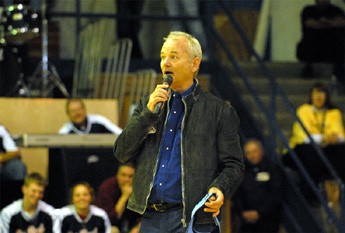This is an article from The Manhattan Mercury, written by Kevin Elliott:
Staff photo by Rod Mikinski

Actor Bill Murray enlivened the atmosphere at Manhattan High School’s basketball games Friday night, honoring his mentor, Del Close. A Manhattan High graduate and founder of the Second City comedy troupe who died several years ago, Close was one of four inductees to the school’s Wall of Fame. Murray accepted the honor in his memory.
Close was an actor, comic, writer and teacher, considered one of the most innovative influences on improvisational theatre. He was one of four inductees Friday. Also honored were actress Inger Stensland (Class of 1952); journalist Bill Buzenberg (Class of 1964); and LPGA golfer Deb Richard (Class of 1981).
Wearing newly bought Wrangler jeans, a blue MHS shirt and a visor, Murray sat in the bleachers prior to the ceremony, watching the game and signing autographs during play stoppages. Apparently improvising his speech, he combined a subtle honor to Close with a more direct message to students in the crowd: You can achieve great things from Manhattan.
Playing on Buzenberg’s comments minutes prior to his own, Murray said “Boozer” was right in saying that MHS taught him he could be whatever he wanted. But, Murray assured students that there is more to come after high school. “None of these people inducted here tonight peaked in high school,” he said. He told the students to work together and respect each other. It ís a principle, Murray said, that helped Close to make individuals become amazing groups, and one that will guide decisions in life. “It’s called being a gentleman,” Murray said. “It’s also called being a lady.” It’s respect, he said, that defines cool. “Being cool means you never make somebody feel uncomfortable,” Murray said. “It’s different from the comparative “cool” in high school.”
Murray ended his speech by invoking more hometown pride. “Del was always proud to say that he was from Manhattan, Kansas,” Murray said. “Go Tribe!”
Joining Murray in accepting the award for Close was friend and author Kim “Howard” Johnson, who co-authored “Truth in Comedy: The Manual for Improvisation” with Del Close and Charna Halpern. Johnson spoke about Close’s reckless youth and adult years and the influence on comedy over three generations.
“Del Close is the only person on the Manhattan High School Wall of Fame that strapped an acetylene torch to his back and flashlight on his head and went roller skating through the sewers of Chicago looking for rats,” Johnson said.
Close had a flare for comedic improvisation even prior to his graduation from MHS in 1952. He and classmate Stensland took first place at the state drama festival. And while still a junior in high school, Close and a group of friends staged his own murder near the corner of 2nd Street and Pierre. With a crowd watching, Close had his friends pretend to gun him down in the dark and stuff his body in the trunk of a car before speeding from the scene. Police from three jurisdictions attempted to look for the killers, but called off the investigation when Close announced the corpse they were looking for was his.
From MHS, Close ran off with a traveling sideshow, where he performed as a fire eater. He returned to Manhattan and attended Kansas State University for a short stint before hitting the road again and joining the Compass Players in St. Louis. He helped form the first cast of the Second City in Chicago in 1959, before moving to New York City to perform stand-up comedy with Lenny Bruce and others.
Among other things, Close performed light shows for the Grateful Dead in San Francisco during the 1960s while founding The Committee comedy troupe. He later returned to Second City as a performer and director, then co-founded Improv Olympics. During his career, Close mentored and taught dozens of actors and comedians including Murray, John Candy, John Belushi, Stephen Colbert, Chris Farley, Tina Fey, Shelly Long, Mike Myers, Gilda Radner, Harold Ramis, and George Wendt.
“Some men say they lead a life of quiet desperation,” Johnson said. “Del said he led a life of wild desperation.” It was the same wild life that claimed the life of Close’s friend and student John Belushi, who died of a drug overdose of a mixture of heroine and cocaine. After Belushi’s death, Johnson said, Close kicked heroin and stopped drinking alcohol. However, Close continued to smoke and developed emphysema.
Close was hospitalized in February 1999. Knowing his death was coming, he held a living wake in his hospital room with nearly 100 guests, Murray serving as master of ceremonies. Close died at the age of 64. Johnson said the doctor who spoke with him last said his last words were “I’m tired of being the funniest man in the room.”
In an apparent attempt to receive casting credits after his death, Close willed his skull to the Goodman Theatre so that it be used in their productions of Hamlet.